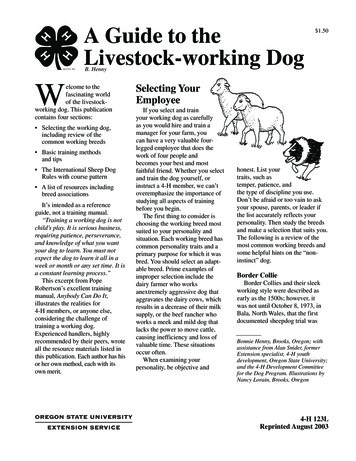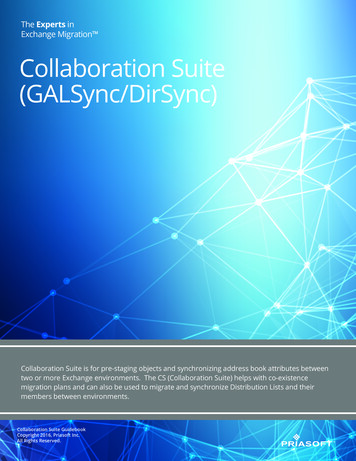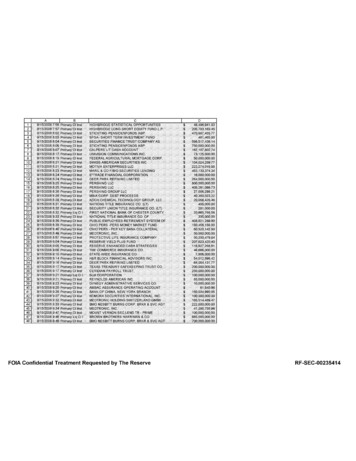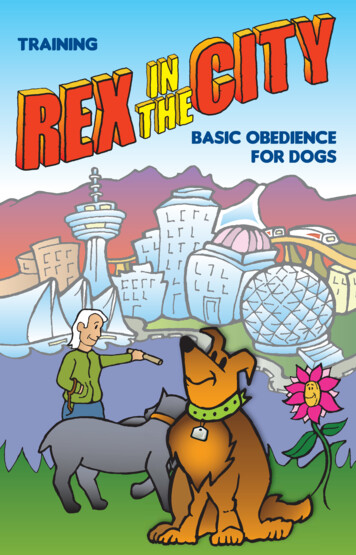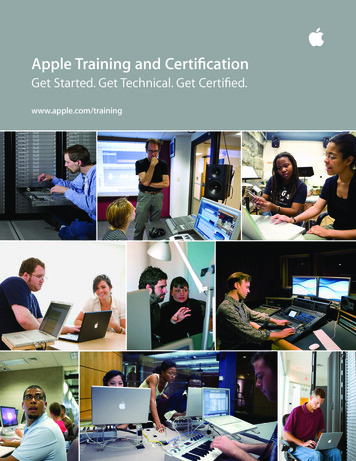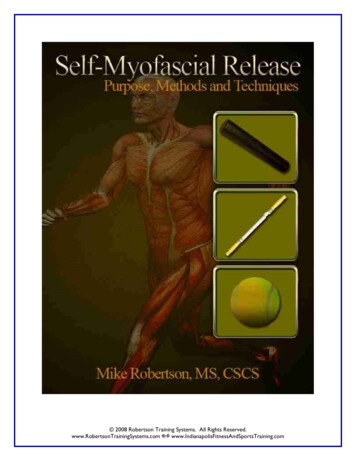
Transcription
2008 Robertson Training Systems. All Rights comwww.RobertsonTrainingSystems.com
Copyright 2008 by Mike Robertson and Robertson Training SystemsAll rights reserved.No portion of this manual may be used, reproduced or transmitted in any form or by anymeans, electronic or mechanical, including fax, photocopy, recording or any information storageand retrieval system by anyone but the purchaser for their own personal use. This manual maynot be reproduced in any form without the express written permission of Mike Robertson,except in the case of a reviewer who wishes to quote brief passages for the sake of a reviewwritten for inclusion in a magazine, newspaper, or journal—and these cases require writtenapproval from Mike Robertson prior to publication.For more information, please ningSystems.blogspot.comThe information in this book is offered for educational purposes only; the reader should becautioned that there is an inherent risk assumed by the participant with any form of physicalactivity. With that in mind, those participating in any exercise program should check with theirphysician prior to initiating such activities. Anyone participating in these activities shouldunderstand that such training initiatives may be dangerous if performed incorrectly. The authorassumes no liability for injury; this is purely an educational manual to guide those alreadyproficient with the demands of such programming. 2008 Robertson Training Systems. All Rights comwww.RobertsonTrainingSystems.com
CONTENTSCHAPTER 1: INTRODUCTION . 5Science.5Rationale .5Indications.6Contraindications .6CHAPTER 2: MODALITIES . 7General Thoughts .7Density and Pressure .7Foam Roller.8Medicine Ball .8Tennis Ball/Lacrosse Ball .9The Stick .9CHAPTER 3: TECHNIQUES . 10Positioning . 10Duration. 10CHAPTER 4: LOWER BODY . 11Plantar Fascia . 11Gastrocnemius . 12Gastrocnemius/Soleus . 13Soleus . 14Achilles Tendon . 15Peroneals (Foam Roller). 16Peroneals (Tennis Ball) . 17Peroneals (The Stick). 18Tibialis Anterior . 19Tibialis Anterior . 20Tensor Fascia Latae, Anterior Gluteus Medius, and Gluteus Minimus. 21IT Band . 22Vastus Lateralis. 23Rectus Femoris (2 Positions) . 24Vastus Medialis . 25Quadriceps . 26Gluteus Maximus . 27Gluteus Medius (Posterior Fibers). 28Piriformis (Foam Roller). 29Piriformis (Tennis Ball) . 30Adductors (2 Positions) . 31Hamstrings . 32 2008 Robertson Training Systems. All Rights comwww.RobertsonTrainingSystems.com
CHAPTER 5: UPPER BODY . 33Pecs . 33Latissimus Dorsi (Foam Roller) . 34Latissimus Dorsi (Tennis Ball). 35Triceps. 36Posterior Shoulder Capsule . 37Thoracic Spine. 38Infraspinatus and Teres Minor . 39Wrist Flexors. 40Wrist Extensors. 41Rhomboids . 42CHAPTER 6: FAQ’S AND CONCLUSION . 43Frequently Asked Questions. 43Conclusion . 44ABOUT MIKE ROBERTSON . 45OTHER PRODUCTS FROM MIKE ROBERTSON . 46CREDITS . 47 2008 Robertson Training Systems. All Rights comwww.RobertsonTrainingSystems.com
CHAPTER 1: INTRODUCTIONFoam rolling is quickly becoming a staple in training programs worldwide. From elite athletes toweekend warriors, you can walk into many training facilities and see people using a foam rolleras part of their regimen.As with any new modality, there are many questions regarding foam rolling. Here are just a fewthat I’ve seen posed: What benefits are derived from foam rolling?Is it safe and effective?When is the best/most optimal time to foam roll?Can foam rolling replace other soft-tissue therapies?While I don’t claim to have all the answers, I do hope to teach you the basics of self-myofascialrelease, along with ways you can integrate it into your current training regimen to elicitimproved results.SCIENCEUnfortunately, science on the subject of foam rolling is seriously lacking. A search of thePubMed archives gives us the following results: “Foam Rolling” delivered seven results, none of which applied to using foam rollers as anSMR technique.“Foam Roller” delivered six results, none of which applied to using foam rollers as anSMR technique.“Self Myofascial Release” delivered three results, none of which applied to using foamrollers as an SMR technique.Lack of good research is quite the conundrum, as it forces us to theorize and speculate on theperceived effects of any medium.RATIONALEThe first question I get when showing someone how to foam roll is, “Why am I doing this?” Ifyou’ve ever performed SMR on yourself, you know the first couple of times are generally quiteuncomfortable!Self-myofascial release (SMR) using a foam roller or other implement is possible thanks to theprinciple known as autogenic inhibition. While you’ve probably never heard of your golgi tendonorgan (GTO) before, it’s the key ingredient that makes foam rolling effective. The GTO is amechanoreceptor found at the muscle-tendon junction; for lack of a better description, it tellsus the level of tension within the muscle/tendon group. 2008 Robertson Training Systems. All Rights comwww.RobertsonTrainingSystems.com
When tension increases to the point of high risk of injury (e.g., tendon rupture), the GTOstimulates muscle spindles to relax the muscle in question. This reflex relaxation is autogenicinhibition. The muscle contraction that precedes the passive stretch stimulates the GTO, whichin turn causes relaxation that facilitates this passive stretch and allows for greater range ofmotion. With foam rolling, you can simulate this muscle tension, thus causing the GTO to relaxthe muscle.Essentially, you get many of the benefits of stretching and then some. It's also fairly wellaccepted that muscles need to not only be strong, but pliable as well. Regardless of whetheryou're a bodybuilder, strength athlete, or ordinary weekend warrior, it's important to havestrength and optimal function through a full range of motion. While stretching will improve thelength of the muscle, SMR and massage work to adjust the tone of the muscle.Traditional stretching techniques simply cause transient increases in muscle length (assumingthat we don't exceed the "point of no return" on the stress-strain curve, which will lead tounwanted deformities). SMR, on the other hand, offers these benefits and the breakdown ofsoft-tissue adhesions and scar tissue.One need not look any further than the overwhelmingly positive results numerous individualshave had with Active Release Techniques (ART) or other deep-tissue modalities to recognizethe value of eliminating adhesions and scar tissue. Unfortunately, from both a financial andconvenience standpoint, we can't all expect to get ART or massage done on a frequent basis.SMR on the foam roller offers an effective, inexpensive, and convenient way to both reduceadhesion and scar tissue accumulation, and eliminate what's already present on a daily basis. Justnote that like stretching, foam rolling doesn't yield marked improvements overnight; you'll needto be diligent and stick with it (although you'll definitely notice acute benefits).INDICATIONSThe following are some reasons you might want to include SMR techniques in your training:Improved mobility and range of motionReduction of scar tissue and adhesionsDecreased tone of overactive musclesImproved quality of movementFill in the gaps between hands-on sessions of ART and/or deep tissue massage CONTRAINDICATIONSThe following are several reasons you may not want to include SMR, or areas to avoid: Recently injured areasCirculatory problemsChronic pain conditions (e.g., fibromyalgia)Bony prominences/joints 2008 Robertson Training Systems. All Rights comwww.RobertsonTrainingSystems.com
CHAPTER 2: MODALITIESGENERAL THOUGHTSLike all things training related, we need to have a rationalized progression if we want to seecontinued progress. SMR techniques are no different—there are multiple ways we can changepressure, density, and other factors to get more bang for our training buck.DENSITY AND PRESSUREBefore we discuss the specific modalities you can use, let’s briefly review the concepts ofdensity and pressure from a physics sense.The formula for density is:Density Mass/VolumeRegarding density and SMR techniques, we have three options if we want to increase thedensity: Increase the massDecrease the volumeIncrease mass and decrease volumeTypically, the easiest option is to increase the mass. This is seen when we progress someonefrom a tennis ball to a lacrosse ball, or from a lighter foam roller to a heavier foam roller. Wedon’t necessarily increase the volume (size) of the object, but we most definitely increase themass.The formula for pressure is:Pressure Force/AreaMuch like density, if you want to increase pressure, you either need to Increase the forceDecrease the areaIncrease force and decrease areaAs is the case with SMR techniques, force doesn’t necessarily change all that much. If you wantto increase the force, here are a few options: If you have both legs on the roller, take one off.If possible, stack one leg on top of the other.If you have a hand/foot on the ground for stability purposes, take it off (this will putmore of the body’s weight on the area being rolled). 2008 Robertson Training Systems. All Rights comwww.RobertsonTrainingSystems.com
Rather than trying to increase force, it’s generally easier to decrease the area. This isaccomplished by using progressively smaller (or more focal) implements. We’ll discuss thedifferent modalities below, starting with the largest surface area and working down to thesmallest surface areas.FOAM ROLLERA foam roller is the largest implement we would use from a pressure perspective. The foamroller is very versatile, as you can work almost every muscle group using a foam roller alone.Rollers also come in varying densities, which allows for progression as well.White Roller – Less DenseBlack Roller – More DenseFoam rollers are best used for the big muscle/fascial areas like the gluteals, quadriceps, and ITband.MEDICINE BALLWhile not as popular as the foam roller, the medicine ball may actually be a more versatile toolfor SMR purposes. Not only is it more focal when compared to the roller (the surface areabeing worked is smaller, which increases pressure), but it also allows you to work in a morethree-dimensional fashion. 2008 Robertson Training Systems. All Rights comwww.RobertsonTrainingSystems.com
Virtually any muscle group that can be addressed with a foam roller can also be addressed witha medicine ball. Once the foam roller becomes comfortable, I generally progress my trainees toa medicine ball. The medicine ball can be progressed as well; simply moving to a smaller ball(and further decreasing surface area being rolled) will increase the pressure and intensity of theexercise.TENNIS BALL /LACROSSE BALLA tennis ball is generally the smallest implement we would use for SMR purposes. It’s veryconvenient for muscle/fascial groups with smaller surface areas (such as the plantar fascia,calves, and peroneals) as well as upper body muscles where the ball must be placed against awall (such as the pecs and posterior shoulder capsule). Once the tennis ball becomes easy,move on to a lacrosse ball.THE STICKThe Stick is yet another convenient tool when it comes to soft-tissue work. While it’s notnecessarily better or worse than the other modalities discussed, it’s narrow diameter allowsyou to work on some tendons (e.g., quadriceps, hamstrings) better than a medicine ball or foamroller would. As well, the Stick is a good option for the hamstrings, which generally don’trespond that well to foam rolling since your hands/arms are supporting the majority of yourbody weight to hold yourself up.The Stick 2008 Robertson Training Systems. All Rights comwww.RobertsonTrainingSystems.com
CHAPTER 3: TECHNIQUESPOSITIONINGPositioning while on the foam roller is critical for several reasons: Poor alignment may stress the supporting muscles and/or joints (e.g., if the elbow is toofar away from the shoulder, instead of being placed underneath it, you could strain themuscle/joint).Improper placement can lead to excessive fatigue of the supporting musculature.Improper placement can lead to excessive pressure on the trained area, whichdecreases compliance. (If it hurts too much, you won’t want to do it again!)We will cover proper alignment and positioning for each specific drill in chapters 4 and 5.DURATIONAs a general rule of thumb, the amount of time necessary to get the derived benefits is directlyrelated to your current tissue quality. In other words, if you have really terrible tissue quality orare unfamiliar with this kind of work, you’ll need more work to bring it up to par. In contrast,the more familiar you become with the techniques and the easier it becomes, the less time youshould need on the roller.In the early stages of training, I generally like my clients/athletes to work on any given areabetween one and two minutes. If an area is particular tight, we’ll spend longer on it. If it’s notthat bad, we’ll spend less time on it. The key is to spend the most time on the tightest tissues.As a client/athlete progresses, they should be spending gradually less and less time on the roller.This is the case for several reasons: High quality programming will work to improve length/tension relationships, naturallyaligning the body and decreasing the likelihood of “overstressed” muscles.Tissue quality should naturally improve due to the inclusion of SMR techniques in theprogramming.The longer a client works with me, the harder I’m going to push for them to get handson manual therapies (e.g., Active Release Technique, deep tissue massage). 2008 Robertson Training Systems. All Rights comwww.RobertsonTrainingSystems.com
CHAPTER 4: LOWER BODYPLANTAR FASCIA Anatomy andFunctionReasons to Treat Excessive tension in the plantar fascia can lead to pain on the bottom ofthe foot. Due to its fascial connections to the gastroc/soleus, hamstrings, and otherposterior musculature, excessive tension in the plantar fascia can lead torestricted ROM into hip flexion and trunk flexion. Set-up Take your shoes off, and place a tennis ball on the ground.Place the sole of one foot on the tennis ball with the other foot on theground.Stand next to a wall, if needed, for balance. Put the majority of your weight on the foot with the ball underneath, androll the ball back and forth along your plantar fascia.Roll for 30–60 seconds, and then switch feet. Use a harder ball to increase the pressure. PerformanceAlternate ModalitiesThe plantar fascia is a band of connective tissue that connects the toes tothe Achilles tendon.The plantar fascia works in conjunction with the Achilles tendon,gastrocnemius and soleus to produce propulsion of the foot/ankle complex(e.g., running, jumping). 2008 Robertson Training Systems. All Rights comwww.RobertsonTrainingSystems.com
GASTROCNEMIUS Anatomy andFunction Excessive tension in the gastrocnemius can cause pain at the site of injury,further down the kinetic chain (in the Achilles tendon or plantar fascia), orfurther up the chain at the anterior/posterior knee. Sit on the ground with your legs straight and calves on top of the roller.Using your arms, press yourself up so that your buttocks are hoveringover the ground. From the starting position, roll back and forth, keeping the knees locked.Focus the pressure on the medial and lateral portions of the calf to workthe medial/lateral heads of the gastrocnemius.Roll for 30–60 seconds.To increase the pressure, try stacking one leg on top of the other androlling only the bottom leg.To further increase pressure, actively dorsiflex the toes (pull them towardyour shin) to place the gastrocnemius on stretch.Reasons to TreatSet-upPerformance Alternate ModalitiesThe gastrocnemius originates from just behind both sides of the knee andinserts onto the Achilles tendon.The gastrocnemius is responsible for plantarflexion of the foot and kneeflexion.Use a tennis or lacrosse ball to increase the pressure. This method isgenerally easier on the arms and upper extremity since you don’t have tohold yourself up. 2008 Robertson Training Systems. All Rights comwww.RobertsonTrainingSystems.com
GASTROCNEMIUS/SOLEUS Anatomy andFunction Excessive tension in the gastrocnemius can cause pain at the site of injury,further down the kinetic chain (in the Achilles tendon or plantar fascia), orfurther up the chain at the anterior/posterior knee. Place one foot up on a low bench.Place the Stick along the posterior surface of your lower leg with yourpalms facing forward. From the starting position, roll the stick up and down the lower leg.To work more on the individual heads of the gastrocnemius, focus thepressure on the medial and lateral portions of the calf just below the knee.Roll for 30–60 seconds, and then switch legs. None.Reasons to TreatSet-upPerformanceAlternate ModalitiesThe gastrocnemius originates from just behind both sides of the knee andinserts onto the Achilles tendon.The soleus originates from just below the knee and inserts onto theAchilles tendon.The gastrocnemius is responsible for plantarflexion of the foot and kneeflexion.The soleus is responsible for plantarflexion of the foot. 2008 Robertson Training Systems. All Rights comwww.RobertsonTrainingSystems.com
SOLEUSAnatomy andFunctionReasons to TreatSet-upPerformance Excessive tension in the soleus can cause pain at the site of injury, orfurther down the kinetic chain (in the Achilles tendon or plantar fascia). Sit on the ground with your legs straight and calves on top of the roller.Using your arms, press yourself up so that your buttocks are hoveringover the ground. From the starting position, roll back and forth, keeping the knees unlocked.Focus the pressure on the medial and lateral areas of the lower part of thecalf, just above the ankle.Roll for 30–60 seconds.To increase the pressure, try stacking one leg on top of the other androlling only the bottom leg.To further increase pressure, actively dorsiflex the toes (pull them towardyour shin) to place the soleus on stretch. Alternate ModalitiesThe soleus originates from just below the knee and inserts onto theAchilles tendon.The soleus is responsible for plantarflexion of the foot.Use a tennis or lacrosse ball to increase the pressure. This method isgenerally easier on the arms and upper extremity since you don’t have tohold yourself up. 2008 Robertson Training Systems. All Rights comwww.RobertsonTrainingSystems.com
ACHILLES TENDON Anatomy andFunction Excessive tension in the Achilles tendon can lead to issues further up (thegastrocnemius/soleus) or further down (the plantar fascia) the kineticchain. Sit on the ground with your legs straight and calves on top of the roller.Using your arms, press yourself up so that your buttocks are hoveringover the ground. From the starting position, roll back and forth, using both a knees lockedand knees unlocked position.Focus on rolling from the top of your heel to midway up your lower leg.Roll for 30–60 seconds.To increase the pressure, try stacking one leg on top of the other androlling only the bottom leg.To further increase pressure, actively dorsiflex the toes (pull them towardyour shin) to place the Achilles tendon on stretch.Reasons to TreatSet-upPerformance Alternate ModalitiesThe Achilles tendon connects the gastrocnemius and soleus to thecalcaneus.The Achilles tendon aids the gastrocnemius/soleus in producing plantarflexion.Use a tennis or lacrosse ball to increase the pressure. This method isgenerally easier on the arms and upper extremity since you don’t have tohold yourself up. 2008 Robertson Training Systems. All Rights comwww.RobertsonTrainingSystems.com
PERONEALS (FOAM ROLLER)Anatomy andFunction The peroneals originate from just below the outside of the knee and insertonto the bottom of the foot. Peroneus longus and brevis are responsible for plantar flexion andeversion. Peroneus tertius assists with dorsiflexion. Excessive tension or adhesions in the peroneals can produce lateral kneepain, or compression of the peroneal nerve which can produce numbnessand/or tingling in the lower leg and foot. Lie on your side on the ground with the roller underneath the outside ofone leg.Place the same side elbow and the opposite hand/foot on the ground.Reasons to TreatSet-up PerformanceAlternate Modalities From the starting position, press up and roll back and forth over theoutside portion of your lower leg.Roll for 30–60 seconds, and then switch legs.To increase the pressure, try stacking one leg on top of the other androlling the bottom leg.Use a harder roller to increase the pressure.Use a tennis or lacrosse ball to increase the pressure. 2008 Robertson Training Systems. All Rights comwww.RobertsonTrainingSystems.com
PERONEALS (TENNIS BALL)Anatomy andFunction The peroneals originate from just below the outside of the knee and insertonto the bottom of the foot. Peroneus longus and brevis are responsible for plantar flexion andeversion. Peroneus tertius assists with dorsiflexion. Excessive tension or adhesions in the peroneals can produce lateral kneepain, or compression of the peroneal nerve which can produce numbnessand/or tingling in the lower leg and foot. Place your foot up on a low bench or chair.Place a tennis ball along the outside of your lower leg. From the starting position, roll the ball up and down along the outsideportion of your lower leg.Roll for 30–60 seconds, and then switch legs. Use a lacrosse ball to increase the pressure.Reasons to TreatSet-upPerformanceAlternate Modalities 2008 Robertson Training Systems. All Rights comwww.RobertsonTrainingSystems.com
PERONEALS (THE STICK) Anatomy andFunctionReasons to Treat The peroneals originate from just below the outside of the knee and insertonto the bottom of the foot.Peroneus longus and brevis are responsible for plantar flexion andeversion. Peroneus tertius assists with dorsiflexion. Excessive tension or adhesions in the peroneals can produce lateral kneepain, or compression of the peroneal nerve which can produce numbnessand/or tingling in the lower leg and foot. Place one foot up on a low bench.Place the stick along the lateral surface of your lower leg with your palmsfacing inward (towards your body).Performance From the starting position, roll the stick up and down the lower leg.Roll for 30–60 seconds, and then switch legs.Alternate Modalities None.Set-up 2008 Robertson Training Systems. All Rights Reserved.www.Indianap
length of the muscle, SMR and massage work to adjust the tone of the muscle. Traditional stretching techniques simply cause transient increases in muscle length (assuming that we don't exceed the "point of no return" on the stress-strain curve, which will lead to unwanted deformities).


